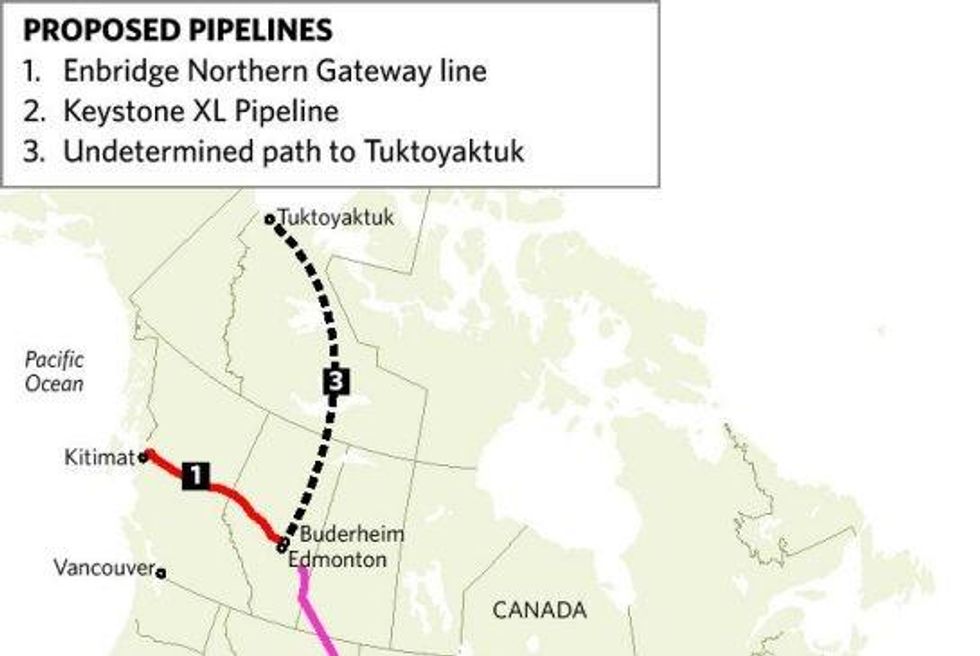Arctic Ho! Canadian Official Proposes Yet Another Tar Sands Pipeline
Energy minister exploring northern option for transporting 500,000 gallons a day of tar sands oil to Arctic ports

Alberta energy minister Ken Hughes announced Friday that the Canadian government is "mulling" the idea of building a line north to an Arctic port.
According to Reuters, Hughes has been in talks with the government of Canada's Northwest Territories about transporting the tar sands via pipeline up the Mackenzie River Valley to a proposed deep-water port at Tuktoyaktuk or Inuvik on the Beaufort Sea, a section of the Arctic Ocean.
CBC reported earlier this week that the Calgary consulting firm Canatec Associates International Ltd. has been hired by the province to study the feasibility of such a project, the results of which are expected by the end of the year.
In addition to the enormous risk posed by building such a pipeline over pristine tundra and the environmental impact that the heated pipeline will have on the permafrost landscape, there are additional technical challenges that would increase the likelihood of a rupture in the line.
On the technical difficulties of building an above-ground pipeline in an Arctic climate, industry publication Pipelines International writes:
[I]f a pipeline is hot and heat is conducted from the pipeline into the soil, the frozen soil thaws, and if it has a large ice content it turns into a soft mud that can carry hardly any load and lets a pipeline sink. The amount of ice in frozen soil varies enormously, even over quite short horizontal distances, and therefore the amount of sinking varies. A pipeline might become severely bent, and in extreme cases might buckle.
Another possibility Hughes mentioned would be ship oil by rail to the Valdez oil terminal in Alaska, Reuters reports.
Whatever the route, the Canadian government can expect similar opposition to the project.
As energy analyst Doug Matthews told CBC, "Many of the communities in that area are currently downstream from the [oil] developments in Fort McMurray and are feeling that there are negative impacts on their communities, on their air, on their fish. They might not be terribly supportive of 500,000 barrels of bitumen flowing past."
_____________________
An Urgent Message From Our Co-Founder
Dear Common Dreams reader, The U.S. is on a fast track to authoritarianism like nothing I've ever seen. Meanwhile, corporate news outlets are utterly capitulating to Trump, twisting their coverage to avoid drawing his ire while lining up to stuff cash in his pockets. That's why I believe that Common Dreams is doing the best and most consequential reporting that we've ever done. Our small but mighty team is a progressive reporting powerhouse, covering the news every day that the corporate media never will. Our mission has always been simple: To inform. To inspire. And to ignite change for the common good. Now here's the key piece that I want all our readers to understand: None of this would be possible without your financial support. That's not just some fundraising cliche. It's the absolute and literal truth. We don't accept corporate advertising and never will. We don't have a paywall because we don't think people should be blocked from critical news based on their ability to pay. Everything we do is funded by the donations of readers like you. Will you donate now to help power the nonprofit, independent reporting of Common Dreams? Thank you for being a vital member of our community. Together, we can keep independent journalism alive when it’s needed most. - Craig Brown, Co-founder |

Alberta energy minister Ken Hughes announced Friday that the Canadian government is "mulling" the idea of building a line north to an Arctic port.
According to Reuters, Hughes has been in talks with the government of Canada's Northwest Territories about transporting the tar sands via pipeline up the Mackenzie River Valley to a proposed deep-water port at Tuktoyaktuk or Inuvik on the Beaufort Sea, a section of the Arctic Ocean.
CBC reported earlier this week that the Calgary consulting firm Canatec Associates International Ltd. has been hired by the province to study the feasibility of such a project, the results of which are expected by the end of the year.
In addition to the enormous risk posed by building such a pipeline over pristine tundra and the environmental impact that the heated pipeline will have on the permafrost landscape, there are additional technical challenges that would increase the likelihood of a rupture in the line.
On the technical difficulties of building an above-ground pipeline in an Arctic climate, industry publication Pipelines International writes:
[I]f a pipeline is hot and heat is conducted from the pipeline into the soil, the frozen soil thaws, and if it has a large ice content it turns into a soft mud that can carry hardly any load and lets a pipeline sink. The amount of ice in frozen soil varies enormously, even over quite short horizontal distances, and therefore the amount of sinking varies. A pipeline might become severely bent, and in extreme cases might buckle.
Another possibility Hughes mentioned would be ship oil by rail to the Valdez oil terminal in Alaska, Reuters reports.
Whatever the route, the Canadian government can expect similar opposition to the project.
As energy analyst Doug Matthews told CBC, "Many of the communities in that area are currently downstream from the [oil] developments in Fort McMurray and are feeling that there are negative impacts on their communities, on their air, on their fish. They might not be terribly supportive of 500,000 barrels of bitumen flowing past."
_____________________

Alberta energy minister Ken Hughes announced Friday that the Canadian government is "mulling" the idea of building a line north to an Arctic port.
According to Reuters, Hughes has been in talks with the government of Canada's Northwest Territories about transporting the tar sands via pipeline up the Mackenzie River Valley to a proposed deep-water port at Tuktoyaktuk or Inuvik on the Beaufort Sea, a section of the Arctic Ocean.
CBC reported earlier this week that the Calgary consulting firm Canatec Associates International Ltd. has been hired by the province to study the feasibility of such a project, the results of which are expected by the end of the year.
In addition to the enormous risk posed by building such a pipeline over pristine tundra and the environmental impact that the heated pipeline will have on the permafrost landscape, there are additional technical challenges that would increase the likelihood of a rupture in the line.
On the technical difficulties of building an above-ground pipeline in an Arctic climate, industry publication Pipelines International writes:
[I]f a pipeline is hot and heat is conducted from the pipeline into the soil, the frozen soil thaws, and if it has a large ice content it turns into a soft mud that can carry hardly any load and lets a pipeline sink. The amount of ice in frozen soil varies enormously, even over quite short horizontal distances, and therefore the amount of sinking varies. A pipeline might become severely bent, and in extreme cases might buckle.
Another possibility Hughes mentioned would be ship oil by rail to the Valdez oil terminal in Alaska, Reuters reports.
Whatever the route, the Canadian government can expect similar opposition to the project.
As energy analyst Doug Matthews told CBC, "Many of the communities in that area are currently downstream from the [oil] developments in Fort McMurray and are feeling that there are negative impacts on their communities, on their air, on their fish. They might not be terribly supportive of 500,000 barrels of bitumen flowing past."
_____________________

